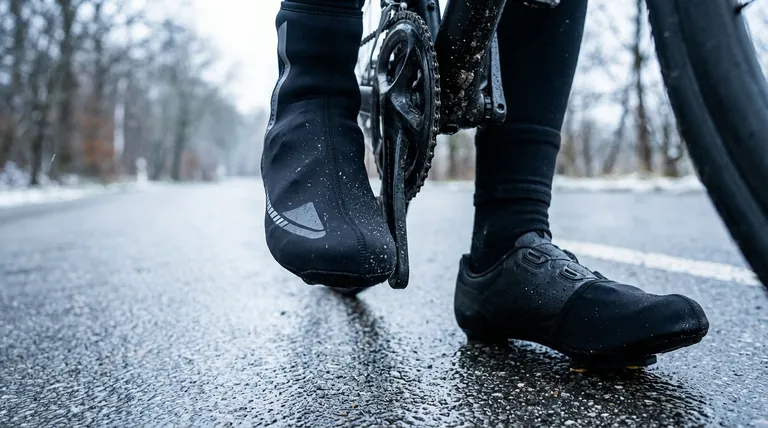For keeping your feet warm on a bike, a full thermal bootie is unequivocally more effective than a simple toe cover. Because they cover the entire cycling shoe, from the toe to the ankle, booties trap significantly more heat and provide a complete barrier against the elements.
The choice between thermal booties and toe covers isn't about which is "better," but which is the right tool for the specific temperature and conditions you're facing. Booties are for the cold; toe covers are for the cool.

The Fundamental Difference: Coverage vs. Compromise
The performance gap between these two pieces of gear comes down to one simple factor: surface area. One is designed for maximum protection, while the other is designed for targeted, minimalist intervention.
How Thermal Booties Work
A thermal bootie, often called an overshoe, is a complete covering for your cycling shoe. It creates a self-contained micro-environment, trapping a layer of insulating air around your entire foot and ankle. This design blocks wind and water from every angle.
How Toe Covers Work
A toe cover, or "toe thingy," is a minimalist piece of equipment. It stretches only over the front portion of your shoe, primarily to block wind from entering the ventilation holes common in most cycling shoes.
Why Full Coverage Maximizes Warmth
Cold feet on a ride are rarely caused by ambient temperature alone. The primary culprits are wind chill and moisture, both of which are better managed by a full bootie.
Blocking Convective Heat Loss (Wind Chill)
Your cycling shoes are designed with vents for warm-weather breathability. In the cold, these vents become a direct entry point for frigid air, which strips heat away from your feet. A toe cover plugs the most obvious holes, but a full bootie seals the entire system, preventing air from circulating around the foot.
Trapping Insulating Air
The most effective insulation is a layer of still, "dead" air. A bootie creates a much larger pocket of this air around your entire foot. Your body heat warms this trapped air, which then acts as a thermal buffer against the outside cold.
Preventing Water Ingress
Wet feet are cold feet. A waterproof or water-resistant bootie provides comprehensive protection from road spray and rain. The ankle cuff is particularly critical, as it stops water from running down your leg and into your shoe from the top. Toe covers offer almost no protection from moisture.
Understanding the Trade-offs
While booties offer superior warmth, they aren't always the best choice. Understanding the practical differences is key to comfort.
The Temperature Spectrum
Think of these as tools for different temperature ranges. Full thermal booties are the go-to solution for deep cold, typically for any ride below 45°F (7°C). Toe covers excel in cool, transitional weather, from roughly 45-60°F (7-15°C), when you just need to take the edge off.
Bulk and Convenience
Toe covers are incredibly small and light. You can easily put them on mid-ride or stash them in a jersey pocket if the day warms up. Booties are a bigger commitment—they are bulkier, take more effort to put on, and are not something you'd typically carry "just in case."
Breathability and Overheating
On a mild day or during a high-intensity effort, a full thermal bootie can easily cause your feet to overheat and sweat. That sweat can then make your feet feel cold and clammy. A toe cover provides targeted wind protection without sacrificing the breathability of the rest of the shoe.
Making the Right Choice for Your Ride
Your decision should be based entirely on the conditions you plan to face.
- If your primary focus is maximum warmth for truly cold rides (below 45°F / 7°C): A full thermal bootie is the only reliable choice for protecting against prolonged cold and wind.
- If your primary focus is fending off the chill on cool, crisp days (45-60°F / 7-15°C): A toe cover provides the perfect amount of minimalist protection without the risk of overheating.
- If your primary focus is versatility for unpredictable weather: A pair of toe covers in your jersey pocket is an invaluable and lightweight insurance policy against a sudden temperature drop.
Choosing the right tool for the conditions ensures you can focus on the ride, not on your feet.
Summary Table:
| Feature | Thermal Booties | Toe Covers |
|---|---|---|
| Coverage | Entire shoe & ankle | Front of shoe only |
| Best For | Below 45°F (7°C) | 45-60°F (7-15°C) |
| Wind Protection | Full barrier | Minimal, targeted |
| Water Resistance | High | Very low |
| Breathability | Lower (risk of overheating) | Higher |
| Portability | Bulky, less convenient | Lightweight, pocket-friendly |
Need High-Performance Cycling Footwear for Your Customers?
As a large-scale manufacturer, 3515 produces a comprehensive range of thermal booties, overshoes, and cycling footwear for distributors, brand owners, and bulk clients. Our production capabilities ensure superior quality, insulation, and weather protection for every condition.
Let's discuss how we can supply the perfect cold-weather cycling gear for your market.
Contact our team today to request a quote!
Visual Guide

Related Products
- Factory Direct Wholesale Rain Boots Durable Waterproof & Fully Customizable
- Customizable Anti-Smash Safety Boots for Wholesale & Private Label Manufacturing
- Custom Wholesale Leather Safety Boots Direct Factory Manufacturing
- Factory-Direct Wholesale Canvas Boots with High-Traction Rubber Soles
- High Performance Fire-Retardant Waterproof Safety Boots
People Also Ask
- What are the drawbacks of rubber boots regarding breathability and comfort? Understanding the Moisture Trap
- What are the liner materials for rain boots? Cotton vs. Blends for Comfort & Durability
- What are the distinctive features of rain boots? Unmatched Waterproof Protection Explained
- What are the limitations of rain boots in certain climates? Find the Right Footwear for Your Weather
- What are the characteristics of rubber as a rain boot material? Discover Its Durability & Flexibility



















